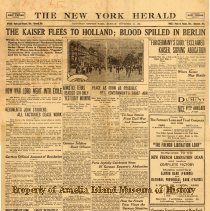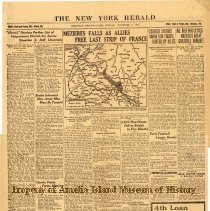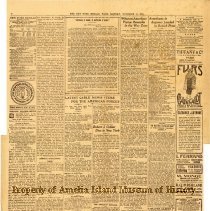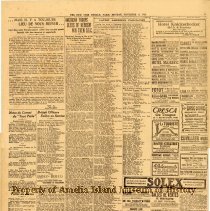Archive Record
Images




Metadata
Title |
The New York Herald Monday November 11, 1918 |
Object Name |
Newspaper |
Scope & Content |
The New York Herald Monday, November 11, 1918. This is not just any issue of the paper. This one is titled European Edition, Paris. The headline for the newspaper is "The Kaiser Flees to Holland; Blood Spilled in Berlin" The front page of the newspaper shows a photo of the street of the Untee Den Linden, Berlin. The story reports that "the Kaiser has fleed to Holland, leaving the wreck of his Empire in the hands of a 'popular' government." "In signing the act of abdication, William II, remarked mournfully: "Let us hope that it is for the good of Germany." The Crown Prince signed away his right it the throne, weeping copiously." The article mentions that a general strike was declared in Berlins on the morning of Saturday November 9, 1918. All work in the factories stopped. "Ebert. the new Chancellor, has issued an impassioned appeal, sounding the cry of famine, and making the feeding of the populace the primary patriotic duty. Reports from the provinces indicate the revolution is gaining all parts of the disintegrated empire." (Page 1) Some of the objectives of the new German government are to "endeavor to obtain peace as quickly as possible for the German people and to make secure the freedom it has won." (page 1) "The new government has assumed power in order to save the German people from civil war and famine and to realize its legitimate claim regarding its right to self-determination." (page 1) In the article titled " For Germany's Good," Exclaimed Kaiser, Signing abdication" It says that "the Emperor signed his letter of abdication last night in presence of the Crown Prince, Hindenburg," as well as many others in his staff saying as he signed "Let us hope that it is for the good of Germany. We must not despair of the future." "The Crown Prince, who wept like a child, signed his right to the throne imediatly afterwards." (page 1) In the article titled "German Officials Account of Revolution" It describes how the events occurred in Germany from a source in Amsterdam. It says "the Wolff Agency is endeavoring to represent the revolutionary movement in Germany as a purely political movement carried out in absolute calm." Saturday was when the new popular government was established. It says that "it is probable that three Independent Social Democratic Deputies will hold portfolios in the new Government, headed by Ebert, together with representives of the groups." It mentions how all parts of Germany report of revolutions, mostly related to economic issues. (page 1) "Workmen of the largest industrial concerns declared a general strike. From all the suburbs they marched in." (page 1) it mentions how "Only those Government decrees which bear Ebert's signature have legal force and the decrees of the War Ministry must bear the signatures of the Social Democrat Deputies." (page 1) There is an article coming from Amsterdam titled "German Soldiers Shoot Officers" It covers how German passengers are reporting "at Cologne the military trains are being seized by civilians and the officers and soldiers disarmed." (page 1) It says "Revolutionists marched to the prisons and released all the prisoners, both military and civilian. Disorders broke out during the night at Gladbach and Rheydt, where the Socialists blew up the powder magazines. All munitions factories are said to have shut down." (page 1) It says that there was a march of soldiers on the bridge from Ruhrort. "Two officers who ordered them to fire on the advancing crowd. The soldiers replied by shooting the two officers and throwing their bodies into the river. The troops, gathering in numbers, marched with the crowd to the town hall, where they hoisted the red flag." (page 1) In the article titled "Hun Troops to Evacuate Tyrol," It says that the new Bavarian Republic ordered the immediate withdrawal of Bavarian troops from Tyrol. (page 1) In the article titled "Ebert definitely recognized as new chancellor" it says that in a "official telegram from Berlin confirms nomination of Herr Ebert, Majority Socialist Deputy of the Reichstag, as chancellor in succession to Prince Max of Baden." (Page 1) In the article titled "Removing Blue Blurs from Parisian lights." It mentions how the removal of blue blurs started on Sunday November 10, 1918. The blue blurs had made it difficult to pass the streets of Paris. The Havas Agency from the Prefecture of the Seine Department put out the statement "that within a few days the lighting of the Paris streets, and also of the suburbs, will be almost as bright as in pre-war days." (page 1) In the article titled "Paris Joyfully Celebrates News of German Emperor's Abdication" it covers how the celebrations went in Paris from different locations by the French, British, and Americans who were in Paris on Saturday November 9, 1918 when news of the German Kaisers downfall had reached the people. Music such as Marseillaise, from an International choir started playing as well as "God Save the King" and the "Star-Spangled Banner." "Busts of cheering could be heard from the Opera to the Bastille." It says at 11:00 PM a large Union Jack went across the boulevards with 8 ment to cary the flag with a large crowd following the men. They said a few short improvised speeches. It mentions how "Paris is preparing to hang flags and bunting." (page 1) In Budapest it says a mob came by assault in to the palace of the Austrian Delegation in Budapest where they tore down the Austrian arms. (page 1) Top left of page 2 says how turnout for the election looks in the U.S.A. House of Representatives and Senate on Republican and Democrat representatives. It reports that the Republicans will control the Senate by a bare majority. It list out who is represeting in each state along with each party. Page 2 has a article reporting "Mézières Falls as Allies Free Last Strip of France." It shows a map of the European front part of Paris, France, Belgium, all the way to Germany. The map shows different lines of German advances and offensives from September 5, 1914, July 1, 1918, March 21, 1918, and present front as of the printing of the newspaper. The article covers how chaotic the retreat is in Germany due to bombardment from allied airmen, complete capture of trains at different points of the advance, especially in Maubeuge. There is a lot of material left behind by the Germans along the front. It describes the retirement of German military has been converted into a rout. The article reports of disorganization amoung the German staff. It says that the British have advanced between Audenarde and Mons. Renaix and Leuze were captured by the British. It reports that the French armies made an advance and "cleared the whole of the northwest of France of Mézières-Charleville. Belgian territory has been entered north-east of Hirson." It reports in "the Second American Army under General Bullard and the French units attached to begin a forward movement east of Verdun" on November 10, 1918. American front that in "the southern outskirts of Stenay, east of the Meuse, have been attained, and further south the village of Gibercy was captured by General Liggett's men." It reports the Americans have captured in the area towards an "important road junction of Etain.The villages of Abauncourt and Gimaucourt-en-Voivre were captured by the Americans. As you go further in the article it mentions more details on how the front line changed at different times during the day on Sunday November 10, 1918. It provides context of how the war lines could change so much from one part of the day to the next. (page 2) There is an article titled "2,827 Hun Planes Fell to British in Five Months." It goes over stastics on fallen planes and the distruction. Some of the stastics reported in the article include "In the same 23 weeks 906 British machines have been reported missing, or less than a third of enemy losses. During the same period 286 raids have been carried out over German towns and 536 tons of bombs have been dropped. The vital points of Thionville and MetzSablons were raided 108 times." (page 2) Top of page 2 has a description of what the weather and what type of moon will be up in Paris France for Monday November 11, 1918. (page 2) In "Latest Cable news in America" -There is a story from Jefferson City Missouri stating the new state capital building installed the largest bronze chandlier. It says it weighs 6,000 pounds and contains 150 lights consuming 5,000 kilowats per hour. (page 2) In the section titled "Latest Cable News Items for the American Forces" there is a section called "Shortage of Farm Labor." The article is reporting from Washington D.C. with the expectation of a shortage of farm workers in 1919 the "due to demand of selective service and the inroads of war industries, the United States Employment Service announces plans are being formulated to extend the recruiting service to farm workers." (page 2) There is a World War 1 poem that is written by a Frenchman in O.D. about the war, the soldiers, the family, and the graves titled "Mother O' Mine, O Mother O' Mine!" found on the top middle of (page 2) There is an article titled "What an American Visitor Remarks in the War Zone" It is an article written from a New York Herald War correspondent as of Sunday November 10, 1918. In the article the correspondent provides descriptions from a trench location for American officers. It had been a trench location that been recovered by Americans of a former German concrete trench location made for the use of German officers and now houses the American officers. It speaks of the living situation for American offocer soldiers dealing with taking a shower using kettles to heat up the water and the rats in the trenches. It descibes how the trenches have different looks to them based on camouflage, flowers, the types of barbed wire put up originally by allies vs the Germans. It also mentions a case how "The guns captured from the Germans are often confusing to the civilian. I saw a group of guns just taken from Germans. They were French guns, which had been captured by the Germans, who in turn lost them to the Americans." some of the big trench signs along the road near the front read as the following "Do your bit and keep to the right. Do your bit, no double baking," The phrase "Do your bit" precedes all other suggestions. It mentions how the German prisoners are working everywhere. Some of the jobs by German prisoners includes making piles of wood that were used for camouflage the roads and now being converted as firewood. It mentions how" The Germans made many of their road screensof bamboo and poultry netting, woven with strips of canvas in a sort of lattice-work (page 2) In the left hand corner there is a long list of 41 different theaters in Paris, France showing a list of the shows they are showing or if they are open, closed for rehearsal or closed. It also includes the times of the show beside the show. (page 2) In a story titled "Big War Loan Boom" On Sunday London reports "During the past six days, the scale of War Bonds, through the Bank of England alone, has totaled £29,250,000, while since the special appeal with which the new issue was heralded an average of not less than £26,250,000 a week has been attained by the Treasury." There is a list different Paris Hotels and famous or well known people who have arrived at the hotel (bottom of page 2) In the article titled "American Troops Deeds of Heroism win them D.S.C. (Distinguished Service Cross) contains a list of people who earned the Distinguished Service Cross with their story on how they earned it. Beside that in "latest American Casualties" there is a lengthy list of names of all the American casualties and deaths that is listed based upon rank, postion, and where they are from based on city and state in the United States. (page 3) In the story titled "Appeal for Shoe Fund for Children of Flanders" It tells how in 1917 they asked the "Herald for money to buy shoes for my 700 'Children of Flanders.' I received 15,000 Francs, and the children were warmly shod for the winter." This year they are asking for 20,000 Francs. It says that they started taking responsibility for the children back in April of 1915. "at the request of the Belgian government, our Committee has given them shelter, food, clothing, medical care, a few weeks at the sea each year and a good professional training as lacemakers and dressmakers." It mentions how some of the older girls have nearly 100 Francs sold. The address given is for Edith Wharton, 53 Rue de Varenne, Paris, France as of November 8, 1918. (page 3) The bottom of page 3 contains a list of many jobs and positions open for employement. Many of the jobs are specifically asking for women. Some of the advertisements included in this paper include - Champagne Duminy (page 1) - Nice Hotel Des Anglais (page 1) - The Farmers' Loan and Trust Company (page 1) - The French Libertion Loan (page 1) - Guaranty Trust Company of New York for the Fourth French War Loan "Emprunt De La Liberation" (page 1) - Barclay for Army Bootmaker and Outfitter (page 1) - Officers' Khaki Shirts (page 1) - New York Herald advertisments price rates. The article also includes prices for the regular vs the European editions subscribers of the New York Herald for Paris, France or abroad. (Top left corner of page 2) - Page 2 is filled with several Art dealers such as - M. Knoedler and Jo. with 3 locations including 556 and 558 Fifth Avenue, New York, USA 15 Old Bond Street, in London, England 17 Place Vendome, in Paris, France. - S. Founes located at 368 Rue Saint-Honore - Roswag located at Place Blanche-cite, Veron, Paris, France. - Reouverture De La Maison Vail Marquereau at 12 Rue Dupetit-Thouars (page 2 right collumn.) - Tiffany & Company has 3 locations 25 Rue de is Paix and Place de Vopere, Paris 221 Regent Street, London, England 5th Avenue and 37th steet, New York City, USA (page 2 right collumn.) - Furs Grunwaldt located at 6 Rue De La Paix Marseille Ro Rue street_Ferreol, Paris, France. The Advertisment shows a woman in a furr coat. (page 2 right collumn.) - Elegance d'Automne located at 43 boulevard des Capucines n'ont Jamais ete concus avec un gout. - I. Ferrand for dresses 281 Rue St-Honore - Harris for Ladies Talloring located at 11 rue Richepance - M. Monge for dresses and mantles located at 18 Chaussee-D' Antin 18 telephone number Central 20.32 - R.Cumberland tailors for uniforms and fur coats. located at 3 Rue Scribe, Paris - Theatre Albert 1er located at 64 Rue Du Rocher (Metro: Villiers, St. Lazore) - Theatre De La Scala - Tommies and Sammies Gather Every evening at the Cadet-Rousselle - Luna Park -London - Daly'd Theatre, in Laicester Square - The London County and Wesminster Bank (paris) Limited located in Paris, France at 22 Place Verdome, Dordeaux, Lyons, and in Marseilles. The advertisment says Special facilities offered to Officers and men of the American Army and Navy for the Negotiation of U.S. Treasury Drafts, Bank Notes and Foreign Moneys, Drafts Drawn Under Letters of Credit. Head Office located at 41 Lothbury, London E.C.2. - The top left of page 3 includes a list of many hotels and resorts. One is in Broadway New York but the rest of the list is for French locations. - Cresca Ox Tongue (page 3) - Roberts & Company American Druggusts located in Rue De Un Paix, Paris (page 3) - La Touriste for Putte, Spirtual extensible located at La Touruste, Paris (page 3) - Cuvillier Wines located at 73 Av. des. Champs-Elysees and also Bordeaux. (page 3) - Bath-Chairs Dupont Contractor to the British and American Red Cross. Located at 10 Rue, Hauefruille, Paris and 6, Place Bellecour, Lyons. - Dogs Pekingese and Japanes from Mrs. Miner, 36 Rue de la Republique, Suresnes, telephone 280 Sureanes (page 3) - Christain Science Reading Room located at 3 avenue de Opera. (page 3) - Goodyear Tire and Rubber Company located at Akron, Ohio, USA, Paris Office located at 17 Rue Saint - Florentin (page 3) - E.B. Meyrosortz optician located at 3 Rue Scribe, Paris, American eye glasses. The London Branch is located at 1a Old Bond St. (page 3) - Fine Panhard Limousine 15-18 Horse power. Carriage de luxe; motors in perfact repair. They are selling it for 10,000 Frances. (page 3) - For Umbrellas Wilson 6 Rue Duphot, Paris, France (page 3) - Gie, Gle, Transat' Antique 6 Rue Auber, Paris (page 3) - Salles De Ventes De Montmartre 23 Rue Fontaine (page 3) - Cunard Line is a shipping and Steamer line (page 3) (To obtain High-res photos use the media tab files) |
Object ID |
2022.090.126 |
Collection |
AIMH Newspapers |
Caption |
The New York Herald November 11, 1918 Page 1 |
Number of images |
4 |
Search Terms |
News (newspaper) News Newspaper History Historic advertisments World War I War German Germans Paris Paris France Parade Soldiers |
Subjects |
Advertisements Advertising Newspaper headlines Newspapers Newspaper industry War Celebrations Strikes Trench warfare War bonds & funds War allies Camouflage (Military science) Agricultural laborers Agriculture Arms & armament Army-Navy stores Arrivals & departures Artillery (Weaponry) Artillery (Troops) Automobile industry Automobile repair Automobiles Banking industry Banking Barbed wire Casualties Children Children & safety City & town life Clothing stores Disaster relief Disabled veterans Economic aspects of war Economic & social conditions Economic & industrial aspects Economic & political systems Economics Economic policy Employment Farming Financial facilities Food prices Food industry Food Footwear Girls Government policy Government regulation Government shutdowns Government spending policy World War I Women War bonds & funds War allies War Violence Victory celebrations Victories Victims of crimes Veterans Vehicle maintenance & repair Unemployment Theater programs Theaters Soldiers Social classes Social aspects Shoes Shooting Restaurants Refugees Protest works Protest movements Prisoners of war Prisoners Prices Politics & government Politicians Political issues Political elections Political conventions Political campaigns Political activity Poetry People Newspaper headlines Newspaper industry Neutrality Military tactics Military standards Military service Military retreats Military officers Military demobilizations Militarism Medical personnel Medical aspects of war Laborers Jewelry stores International organizations Hotels Hospitals |
Date |
11/11/1918 |
